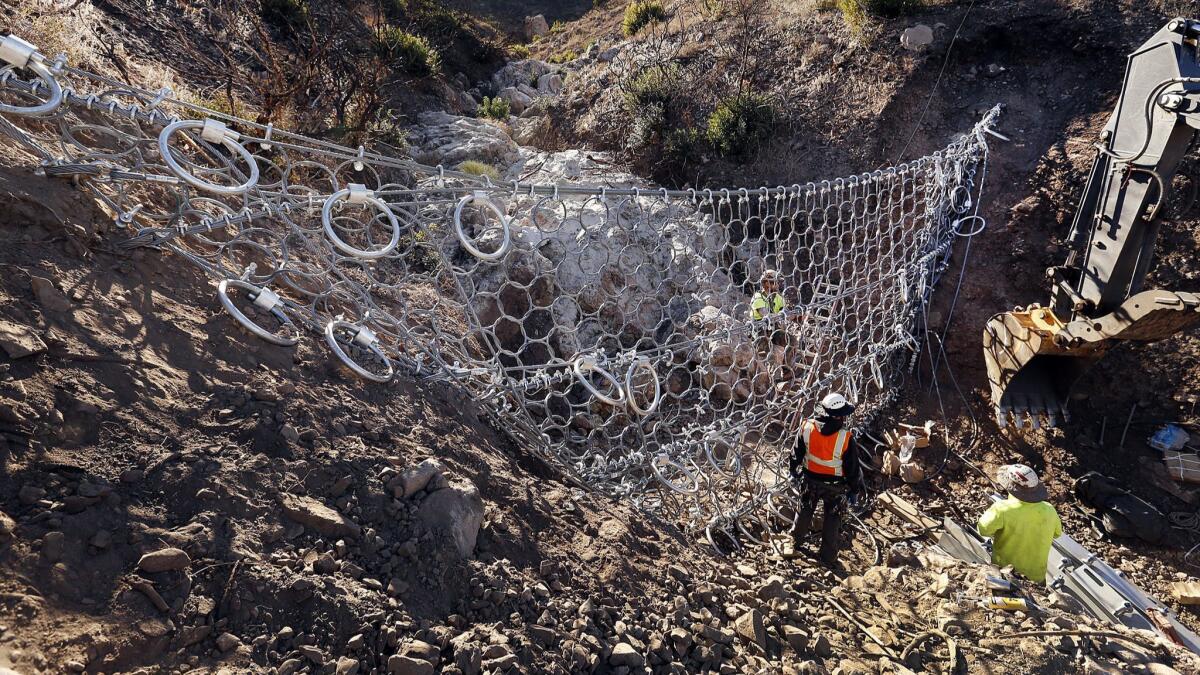Santa Barbara County takes emergency action to better protect Montecito from mudslides

- Share via
Santa Barbara County granted an emergency permit Friday to a private group’s request to install 11 steel ring nets to hold back boulders in canyons above Montecito that led to January’s deadly debris flows.
With the mountains still bare and a wet El Niño predicted for January, the group had been working to convince county, state and federal officials that the hazardous conditions still exist.
“We plan to order these nets today if we can and start installing them the first week of January,” said Patrick McElroy, executive director of the Partnership for Resilient Communities and former chief of the Santa Barbara City Fire Department.
The action by the planning and development department comes a day after The Times published an investigative report showing the county was ill-prepared for the mudslides despite knowing of the threat for decades.
The article detailed how the flood control district failed to regularly empty basins at the bottom of the canyons, reducing the amount of debris that the catchments could trap in a storm. The situation became critical when the Thomas fire burned the watersheds above Montecito and Carpinteria last December, leaving them prone to rapid erosion.
With the fire still burning inland, contractors removed more than 1,200 truckloads of sediment and rock from five basins below the charred mountain front.
But when a county surveyor measured the capacity of those basins — formed by a low dam between the canyon walls — he found their volumes were still much smaller than what the original designs stipulated. Six other basins in burned drainages were not cleaned of debris, according to county records.
The storm came four days later, unleashing debris flows that killed 23 people and destroyed 130 homes.

At Santa Barbara Cottage Hospital after the January storm, a group of residents visiting friends and loved ones injured by the mudslides began talking about what they could do to prevent another catastrophe.
They formed the Partnership for Resilient Communities, hired geo-engineers and began studying how other countries dealt with debris flows. They concluded the most effective measure in the steep, loose terrain of the Santa Ynez Mountains would be the high-tensile nets, designed by Geobrugg in Switzerland. The nets will sit 3 to 5 feet above streams so fish and wildlife could pass, and would be removed when the slopes stabilize with thick vegetation.
The partnership applied for permits Oct. 31. Senior county planner Tess Harris said there was a delay as officials waited to get authorizations from property owners and a revision on one net to prevent it from blocking a popular hiking trail.
“The partnership has stepped up for our community and filled a critical gap,” said Mona Miyasato, Santa Barbara County chief executive.
In the two canyons that caused the worst damage — Cold Springs and San Ysidro creeks — the steel hoop nets will be stretched across the streams at different points above the debris basins. Seven of the nets will be placed in Buena Vista Canyon, which has no basin.
The nets are meant to both trap and slow down boulders and logs.
The group is still working with the U.S. Forest Service and other agencies to get approval for 60 more nets.
On Cold Springs Creek, the nets are expected to trap 9,000 cubic yards of debris that would otherwise fill up a good portion of the debris basin below.
County flood control officials on Friday defended their work before the Jan. 9 storm. Deputy Public Works director Tom Fayram insisted all 11 basins were fully emptied even though the surveys and work records showed otherwise. He said contractors did the work in the five basins that needed the most significant excavation, and county staff did the work in the six basins unaccounted for in the records.
“We have smaller dump trucks, smaller excavators, and we only have a couple of them,” he said.
Fayram provided Mircrosoft Excel spreadsheets and a PDF file, last updated at 5:39 a.m. Friday, showing staff did 458-man hours of work, mostly removing brush, in the other basins. The cost for that work was $29,455 compared to $226,315 in the five other basins.
“There weren’t huge amounts of debris in any of those basins,” Fayram added. “They started from a state of readiness that was pretty much good to go.”
But aerial photos and images on Google Earth show the basins were significantly filled in before the clean-outs, as did the agency’s 231-page maintenance report published in June 2017.
The Arroyo Paredon debris basin above Carpinteria, for instance, was one that did not need “heavy lifting” by contractors after the fire, according to Fayram.
But the report said: “The basin was designed to trap 24,500 cubic yards of flood debris. A 2005 basin survey showed the actual capacity to be 8,360 cubic yards.”
Fayram said he did not understand the numbers in the report — or in the surveys done just before the storm that showed how the numbers were calculated.
“I don’t know what [the surveyor] was referring to because capacity can mean so many different things. It can be what is the capacity of the basin. It can be what is the capacity at the time. I don’t know what that means.”
Other debris control experts whom The Times consulted said the wording and surveys were clear: The basins had filled up with sediment during storms and were not cleaned out.
Fayram said there were different ways to calculate capacity and that he would try to “standardize” them going forward. “I recognize we don’t know how those numbers were generated.”
Twitter: @joemozingo
More to Read
Sign up for Essential California
The most important California stories and recommendations in your inbox every morning.
You may occasionally receive promotional content from the Los Angeles Times.








